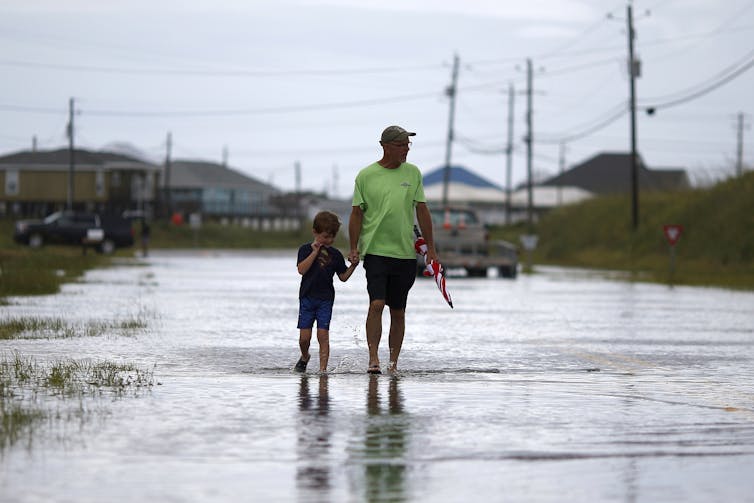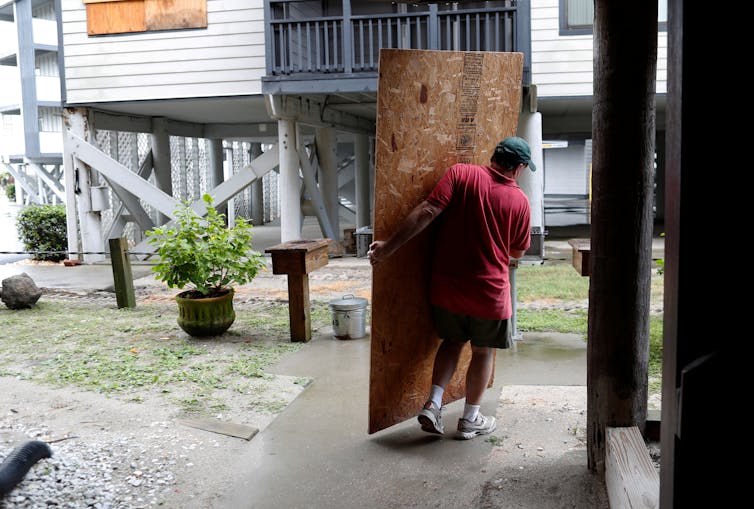What is flood insurance and why the system is broken: 6 questions answered
- Written by Robert W. Klein, Director, Center for RMI Research, Associate Professor, Risk Management and Insurance, Georgia State University
Editor’s note: Homeowners generally rely on insurance provided by the federal government to cover the costs of rebuilding their lives after a flood. We asked an insurance expert to explain the government program and its challenges.
1. What is flood insurance?
Homeowners’ insurance does not cover damage to a home caused by flooding. A homeowner must have a separate policy to cover flood-related losses, defined as water traveling along or under the ground.
Most such policies are underwritten by the National Flood Insurance Program[1], which is part of the Federal Emergency Management Agency. The program was established in 1968 to address the lack of availability of flood insurance in the private market and reduce demand for federal disaster assistance. It also contains provisions[2] intended to reduce flood risk.
The National Flood Insurance Program’s activities are funded largely by the premiums and fees paid by its policyholders, supplemented by a little from the federal budget to help pay for flood risk mapping. Because the program serves the public interest, some[3] believe that more of its funding for flood risk management should be borne by taxpayers.
Homeowners can purchase a federal flood policy directly from the program or through a private insurer. Separately, some private insurers sell their own flood policies on a limited basis for properties that are overcharged by the government’s program.
 After Tropical Storm Gordon struck Dauphin Island, Alabama, earlier this year, Mickey Kiker and his girlfriend’s grandson Cooper O'Brien walked down the flooded street.
Reuters/Jonathan Bachman[4]
After Tropical Storm Gordon struck Dauphin Island, Alabama, earlier this year, Mickey Kiker and his girlfriend’s grandson Cooper O'Brien walked down the flooded street.
Reuters/Jonathan Bachman[4]
2. How many homeowners have flood insurance?
It is difficult to determine exactly how many homeowners have flood insurance.
The National Flood Insurance Program had just over 5 million policies in force[5] as of May 31. Of these policies, approximately 69 percent were on single-family homes and 21 percent on condo units. There is no source on how many private flood policies are in force, but my sense is that it is comparatively small.
In recent years, the number of such policies has been dropping across the country over concerns about the cost and an underestimation of the risks. Some of the counties hardest hit by Hurricane Harvey in 2017, for example, such as Harris (which includes Houston), have experienced significant declines[6].
A more revealing – and more difficult to ascertain[7] – stat is the share of homeowners in a disaster area who actually have flood insurance. In Harris County, for example, experts estimate[8] that only about 15 percent of homeowners were insured for floods – though the percentage is likely higher in areas near coastlines.
Real estate data company CoreLogic[9] estimated that approximately 75 percent of flood losses from Harvey were uninsured, a figure that rises to about 80 percent for Hurricane Irma.
3. Why do people at great risk forgo insurance?
A number of factors[10] affect a homeowner’s decision to buy flood insurance – or not.
People who perceive that their exposure to floods is high are more likely to buy it, all other things equal. While a mandatory purchase requirement[11] is intended to force owners of mortgaged homes in areas at high risk of flooding to buy insurance, it’s estimated[12] that only about half of them do.
One reason might be that 43 percent of homeowners incorrectly believe[13] that their homeowners’ insurance covers them for flood losses.
Other factors also come into play, such as a lack of information, the difficulty of calculating flood risk and the expectation that the government will provide disaster assistance that will fully cover a homeowner’s uninsured flood losses – which is in fact rarely the case[14].
4. What does flood insurance cover?
With a National Flood Insurance Program policy[15], a homeowner can purchase coverage on a dwelling up to US$250,000 and the contents of a home up to $100,000. It does not cover costs associated with “loss of use” of a home.
These limits have been in effect since 1994 and are no longer high enough to account for the increase in the replacement cost of homes and the actual cash value of their contents. As a result, some homeowners buy additional flood protection from private insurers to make up any shortfall.
 In preparation for Hurricane Florence, John Muchmore helped attach hurricane shutters to houses in Garden City Beach, South Carolina.
Reuters/Randall Hill[16]
In preparation for Hurricane Florence, John Muchmore helped attach hurricane shutters to houses in Garden City Beach, South Carolina.
Reuters/Randall Hill[16]
5. Why is the federal program underwater?
The National Flood Insurance Program has faced considerable criticism[17] over its underwriting and pricing of policies, which have resulted in a substantial debt. Essentially, its premiums are not high enough to cover how much it pays out on claims and its other costs.
Part of the problem is that about 20 percent of the properties[18] the program insures pay a subsidized rate. But many other National Flood Insurance Program policyholders are also paying premiums substantially less[19] than what it costs to insure them because the rates do not adequately account for the catastrophic losses incurred during years when more major storms than normal strike, such as Katrina and Rita in 2005 and Sandy in 2012.
To show how much single storms can cost, the National Flood Insurance Program paid out $8.7 billion[20] to cover Harvey-related flood losses, $16.3 billion for Katrina and $8.8 billion for Sandy.
These inadequate rates also exacerbate the moral hazard created by flood insurance[21]. People are more likely to buy, build or rebuild homes in flood-prone areas and have diminished incentives to invest in flood risk mitigation, such as by elevating their home, if they can buy insurance at below-cost rates.
Although Congress forgave[22] $16 billion in debt last year, the National Flood Insurance Program still owed $20.5 billion[23] to the U.S. Treasury as of February.
Hurricane Florence and other storms that may follow will substantially increase this debt – and may require more forgiveness.
6. What can be done to fix the program?
Legislative efforts to reform the National Flood Insurance Program to put it on firmer fiscal footing have produced mixed results.
The Biggert-Waters Act of 2012[24] made a number of changes to the program, such as increasing premiums, to make it “more financially stable[25].” While that would have gone a long way to restore its fiscal solvency, an outcry from homeowners in high-risk areas led to the 2014 Homeowners Flood Insurance Affordability Act[26], which limited or rescinded many of the Biggert-Waters rate increases.
Currently, there is a bill[27] in Congress that would fix some but not all of the problems with the program, such as by making it easier for private companies to sell their own policies and tightening the rules for properties that suffer repetitive losses.
But its prospects are dim to opposition from legislators concerned about some of its changes, particularly its rate increases and the repetitive loss provision.
Fundamentally, the program millions of Americans rely on to help them rebuild their lives after a devastating flood needs to be fixed[28]. Its dire financial straits could be resolved by either making taxpayers foot more of the bill or increasing premiums closer to full-cost rates for most homeowners, while also raising total coverage levels.
At the same time, I believe the government needs to do more to convince or compel more at-risk homeowners to buy flood insurance – which would be harder to do if it were to raise rates. To me, this suggests that increasing taxpayer support for the the program will have to be part of the solution so that pricey premiums don’t become a deterrent to someone buying insurance.
This is an updated version of an article[29] originally published on Sept. 7, 2017
References
- ^ National Flood Insurance Program (www.fema.gov)
- ^ provisions (www.fema.gov)
- ^ some (morningconsult.com)
- ^ Reuters/Jonathan Bachman (pictures.reuters.com)
- ^ had just over 5 million policies in force (www.fema.gov)
- ^ have experienced significant declines (abcnews.go.com)
- ^ more difficult to ascertain (bsa.nfipstat.fema.gov)
- ^ experts estimate (abcnews.go.com)
- ^ CoreLogic (www.corelogic.com)
- ^ number of factors (riskcenter.wharton.upenn.edu)
- ^ mandatory purchase requirement (www.fema.gov)
- ^ it’s estimated (www.bloomberg.com)
- ^ incorrectly believe (www.iii.org)
- ^ rarely the case (www.nytimes.com)
- ^ National Flood Insurance Program policy (www.fema.gov)
- ^ Reuters/Randall Hill (pictures.reuters.com)
- ^ has faced considerable criticism (www.gao.gov)
- ^ about 20 percent of the properties (www.fema.gov)
- ^ substantially less (www.foxbusiness.com)
- ^ paid out $8.7 billion (www.fema.gov)
- ^ moral hazard created by flood insurance (blogs.colgate.edu)
- ^ forgave (www.businessinsurance.com)
- ^ $20.5 billion (www.treasury.gov)
- ^ Biggert-Waters Act of 2012 (www.fema.gov)
- ^ more financially stable (www.fema.gov)
- ^ Homeowners Flood Insurance Affordability Act (www.fema.gov)
- ^ bill (www.congress.gov)
- ^ needs to be fixed (www.rff.org)
- ^ article (theconversation.com)
Authors: Robert W. Klein, Director, Center for RMI Research, Associate Professor, Risk Management and Insurance, Georgia State University

